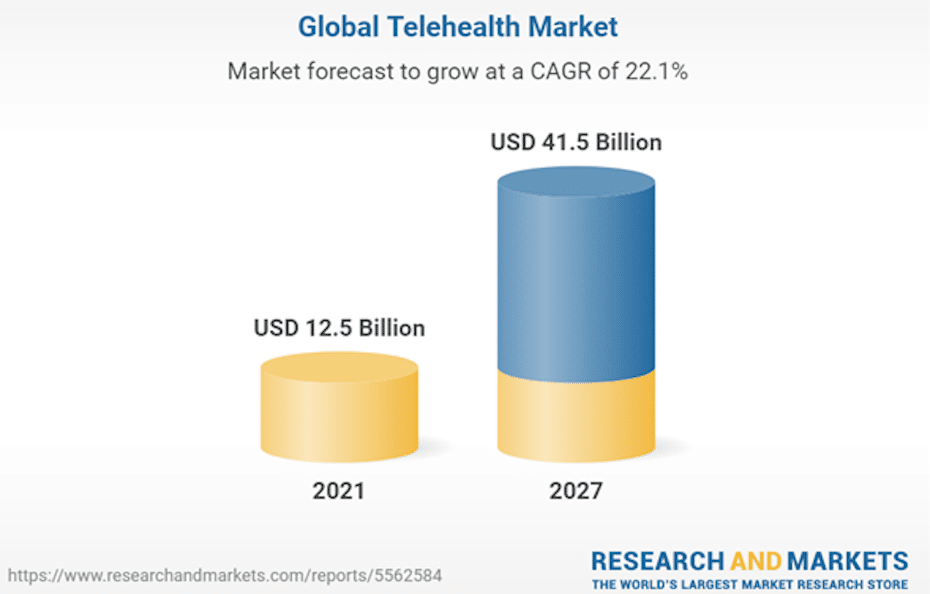- Telehealth usage rates exploded in the spring of 2020 and have remained high according to recent studies.
- Telehealth is projected to maintain a 22.1 percentage CAGR through 2027.
- Factors including technology expansion, new care uses, and provider and patient acceptance will impact the future of telehealth.
- Providers play a critical role in maximizing telehealth benefits by investing in technology, communicating telehealth options, and expanding medical licensing.
🧑⚕️⚕️👨🏻💻 How do patients really feel about telehealth today? Find out with our free infographic.
Telehealth exploded following the global health crisis of 2020. In April 2020, medical claims for telehealth visits were 78 times higher than they were in February 2020. Even a year later, in February 2021, claims were still 38 times greater than they were pre-pandemic.
Medical providers, insurers, and patients all recognize the significant benefits of telehealth, particularly when in-person visits are impractical. Thus, telehealth usage is expected to remain steady moving forward.
The following is a look at projected rates of telehealth use in the future, factors that contribute, and steps providers can take to maximize the strengths of telehealth.
Projected outlook for telehealth
According to the ResearchandMarkets.com report “Telehealth Market: Global Industry Trends, Share, Size, Growth, Opportunity and Forecast 2022-2027,” the global telehealth market is expected to top $41.5 billion in 2027. That amount is 3.32 times the size of the market in 2021, which equates to a 22.1 percent CAGR.

The Census Bureau’s Household Pulse Survey (Data from April-October 2021) showed that 23.1 percent of adults in the United States had participated in a telehealth appointment in the most recent 4-week period included in the survey.
This data shows that telehealth has remained stable even as the number of pandemic cases has diminished, and that telehealth use is not going away when the pandemic effectively ends. Since reported cases still fluctuate, there is some uncertainty about the ongoing impact of the pandemic on telehealth visits in the near term.
Factors that will impact telehealth usage rates
The following are five key factors that will influence the rate of telehealth usage moving forward.
1. Insurance coverage
Insurance coverage for telehealth was limited prior to 2020. During the global health crisis, state regulations supporting telehealth and insurance carrier buy-in to the need for telehealth grew exponentially. Insurers recognize the cost advances of telehealth appointments, as well as the impact of routine care visits in the early detection of illness and disease. Thus, insurance coverage for telehealth is likely to endure.
2. Continuation of special health circumstances
Social disease spread and seasonal infections like influenza and the demands placed on the healthcare systems will create higher demands for virtual health services.
3. Evolution of technology
Quality telehealth care is dependent on capable digital communications technology and reliable internet connections.
4. Recognition of various healthcare uses
As time goes on, medical practitioners recognize more circumstances in which telehealth can play a role. Beyond routine visits, telehealth has become significant in continuous and collaborative care.
5. Acceptance by practitioners and patients
In addition to insurance carriers, higher rates of acceptance of telehealth by medical providers and patients embed it more firmly in the industry.
Provider role in maximizing telehealth benefits
Medical providers play a crucial role in the success of telehealth, and therefore its ongoing acceptance by insurers and patients. The following are three key things providers can do to maximize the benefits and value of telehealth.
1. Invest in technology
Reliable internet and a unified communications system are foundational technology components to optimized telehealth. A top UCaaS ensures stable connections with patients during visits and flexible communication methods (including video, audio, chat, and email). It also supports collaboration with other providers, including the ability to review recordings of conversations.
2. Promote telehealth access
The Census Bureau’s Household Pulse Survey showed significant sub-group discrepancies in telehealth usage rates. Medicare and Medicaid patients, Black individuals, and low-income earners had the highest usage rates. Uninsured people and young adults (18-24) had the lowest usage rates. Communication of telehealth options within these sub-groups, as well as in other sub-groups, can help sustain and grow interest.
3. Expand medical licensing
Medical providers are typically licensed to practice only in their home state, or in their home state plus neighboring states. To grow patient reach, and to serve existing patients from a distance, providers may have to work to expand licensing in more states. However, licensing requirements vary by state. Providers also need to be cognizant in ensuring that appointments are held with patients only when they are in a state where the provider holds a license.
RingCentral supports the future of telehealth
Telehealth is convenient for providers and patients and cost-effective for providers and insurance companies. It also makes it more feasible for patients to engage in routine preventative or maintenance care visits, which reduces reliance on intensive treatments.
For telehealth to remain viable, practitioners need a strong digital communications system in place. A top solution enables quality, reliable visits between providers and patients. It also allows for more effective and tracked interactions between providers who collaborate on patient care.
RingCentral is a leading cross-channel, cloud-based unified communications system. It offers reliable connectivity so you don’t have to deal with appointment disruptions. It also allows for easy transitions between different channels of communication to meet patient demands and optimize interaction efficiency. It has advanced security features to ensure the privacy of your patients.
Originally published Jun 28, 2022





